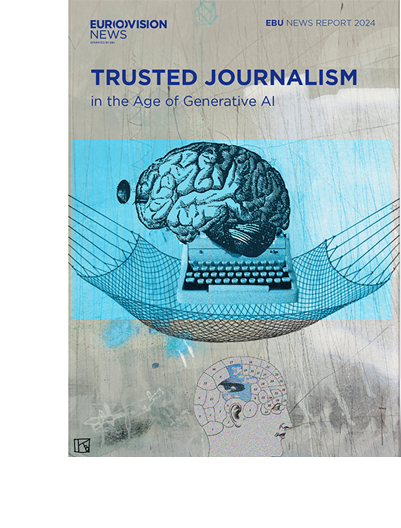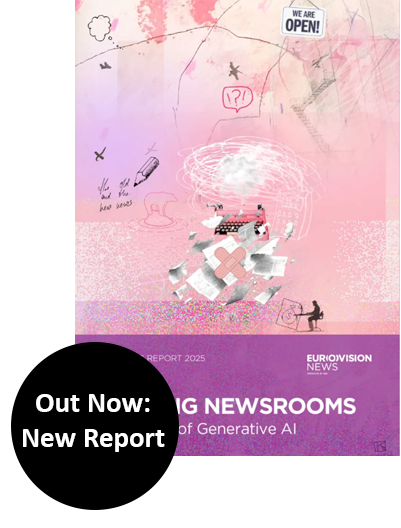Middle management in companies more often than not suffers from its infamous reputation. They are branded as rule-abiding busy bees, nitpickers who stick to processes just as much as they stick to their own chairs, managers, definitely not leaders. If they were, they would have long been promoted to the top – or so it is taught in many a business school. Former Siemens CEO Peter Löscher once spoke of a “clay layer,” the term even survived his own career in the company. A word that is like a slap in the face of all those tireless getting-things-doners who not only keep the company running on a daily basis, but also strive for constant improvement and overhaul, whether there is a crisis or not.
In the media industry, bosses are apparently no longer so sure about that clay layer. In the new “Journalism, media and technology trends and predictions” report by Nic Newman, which the Reuters Institute in Oxford publishes regularly at the beginning of the year, top managers were at least refreshingly self-critical about their own capacity to generate top ideas. Only about one in four (26 percent) of the 234 executives surveyed from 43 countries said they were convinced that top management generates the best ideas. The problem, as Nic Newman frames it: Innovation might not come from the top, “but companies are still run that way”. The report is not representative, but it is a must-read in the industry precisely because the respondents tend to be leaders who are particularly concerned about progress.
But where do they see innovation coming from? Nearly three-quarters revealed that data and audience research were most likely to give them a leg up, 68 percent bet on mixed teams from different areas, and still just under one in two admitted to borrowing the best strategies from other media companies. Okay, according to the survey, editors-in-chief and media managers trusted middle management as such even less (17 percent) than they trusted themselves. But who meets in the mixed teams, who evaluates audience data and derives strategies from it, who attends the relevant industry meetings, reads up on foreign material and then reports to the C-level? That’s right, in the very most common case, it’s the mid-level.
It is often those who are not celebrated as heroes in any industry publication and who neither management literature nor research has an eye on. They are the ones who are closest to the difficulties – and often therefore to the solutions. But they are also the ones for whom demands from employees and customers alike pile up into a sandwich of expectations. They are expected to be both operationally reliable and to think strategically and manage change. And if something goes wrong, it’s up to them to pick up the pieces and rebuild them into something else – in management-speak this is coined as “celebrating failure.
This layer of dedicated and loyal drivers of innovation, many of whom are at an age and in situations where family work demands additional work from them, is – no surprise – most at risk of burnout. Lucy Küng, who researches cultural change in media companies that go digital, has revealed this in countless interviews, including in her latest book: “Hearts and Minds: Harnessing Leadership, Culture and Talent to Really Go Digital.” This results in a huge brain and talent drain, she emphasizes again and again.
Yet many managers consider the mid level worthy of support only as long as they themselves are part of it. As soon as they have made it into top positions, they recoin themselves as visionaries. Gianpiero Petriglieri, a professor at INSEAD Business School, calls this “leaderism.” Instead of valuing reliable and constructive management, which is so necessary especially in times of crisis, he says, people celebrate visionaries whose ideas all too often go down with them. The glorification of leadership on the one hand and the devaluation of management qualities on the other is a dangerous pair of opposites that is still taught, but does more harm than good, especially in crises, he eloquently describes in the essay: “Why leadership isn’t a miracle cure for the Covid-19 crisis (and what can really help).” It is time to put less hope in leadership and more humanity into management, Petriglieri said. Judging by the “Trends and Predictions” report, many media managers already understand this. Humility can be the first step toward innovation.
This text was first published in German with Hamburg Media School Blog on 15th January 2021, then translated with www.DeepL.com/Translator and edited.




MUNICH – When a local radio station in Charlotte, North Carolina started a podcasting competition in its community, it was prepared for many contingencies, except one: that the response would overwhelm the station’s server. The initiative was aimed at increasing on-air diversity, and tens of thousands of people wanted in. Groups and individuals from all walks of life submitted more than 370 ideas for podcasts, and 33,000 listeners logged on to vote for them. What started as a one-time experiment will now be a regular feature.
Journalism has always suffered from a lack of diversity. Demographically uniform newsrooms have been producing uniformly homogeneous content for decades. And while editors around the world have increasingly recognized that this is a problem, too little has been done to address it.
One reason, ironically, is a preoccupation with digital change. “There has been so much focus on digital transformation in recent years, the question of diversity has had to stand aside,” explains Olle Zachrison of the Swedish public broadcaster Sveriges Radio, in a study comparing diversity efforts in the United Kingdom, Sweden, and Germany. And yet, as the newsroom in Charlotte discovered, diversity is not just an added bonus; it is at the very core of audience engagement today.
In explaining the business ethos of the digital age, Amazon founder Jeff Bezos has argued that it is all about “customer obsession as opposed to competitor obsession.” For the media, then, the guiding principle should be “audience first.” And that means using data to understand and cater better to it.
Not long ago, editorial choices were guided mostly by gut feelings and assumptions, whereas now they are often informed by analytical metrics and revealed truths about audience behavior. Some of these revelations are uncomfortable. Editors can no longer fool themselves about their journalism’s real-world impact. They now know that even the best stories tend to reach just a fraction of their hoped-for audience.
Complicating matters further, newsrooms have discovered that demand can peak at times when they have no new offerings, or when what they’re serving is not what consumers are seeking. In surveys like the Digital News Report, respondents often complain that the media offer too much negativity and volume, and too little explanation and relevant coverage.
Before digitalization, journalists didn’t have to think about their audiences as much as they do now. Newspapers were money-printing machines – the advertising dollars poured in regardless of what would now be called “content.” Likewise, public-service media faced almost no competition. But now that digital information is a commodity, with a few major platforms controlling its distribution, audience loyalty has become a matter of survival.
Many newsrooms were entirely unprepared for this new reality. They don’t even know who their potential new customers are, let alone how to reach them and win their trust. The problem is not just that newsroom homogeneity results in an incomplete view of the world and of the reading/listening public. It is that even when “outsiders” do land a job in this kind of environment, they tend to adapt to the dominant culture rather than challenge it. As a result, newsrooms remain ill equipped to reach out to new audiences.
The lack of diversity in the media has actually worsened in recent decades. Back in the heyday of local news, newsrooms were no less white or male, but being a journalist at least didn’t require a university degree – only a willingness to dive in and chase leads. Yet as the industry became concentrated more in big cities and employment prospects elsewhere diminished, education became yet another entry barrier. While the better-educated candidates moved up to higher-profile jobs, many others left the profession altogether.
In keeping with the industrial society of the time, the occupational model that followed from these changes was hierarchical. As with teachers and their pupils, preachers and their congregations, and experts and the lay public, education conferred status and authority upon journalists. The public was a passive recipient of information, not an engaged participant in a broader conversation.
Clinging to this hierarchical structure is now a recipe for failure. The digital world of information is one of choice and abundance, but also of considerable confusion about what is true and false. Trust is a news organization’s most valuable asset, and the task for journalists is both to challenge and inspire their audience, and to invite conversations among them.
That can’t happen unless journalism represents the society in which it is operating. Unfortunately, a recent global survey of media leaders finds that while editors see progress toward gender diversity, much more must be done to achieve racial and political diversity, as well as a balance between “urban” and “rural” backgrounds. The most likely reason for this failure is that industry leaders continue to regard the digital transformation as a matter of technology and process, rather than of talent and human capital.
Fortunately, the digital transformation represents an opportunity. As Jeff Jarvis of the City University of New York explains, industry leaders should “Try listening to, valuing, and serving the people and communities who were long ignored and left unserved by our old industry, mass media.” All news organizations should take Jarvis’s advice – and not just because it is the right thing to do. Their own survival depends on it.
This commentary was published in ten languages by Project Syndicate on June 25, 2020